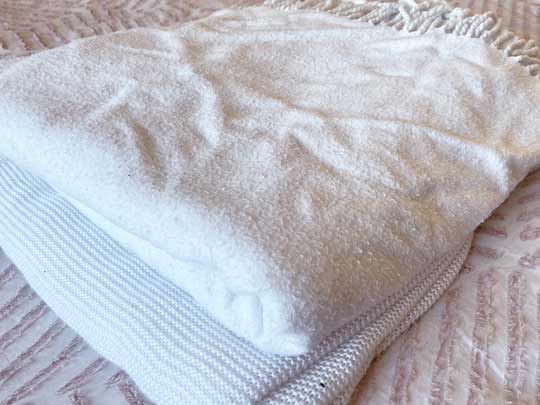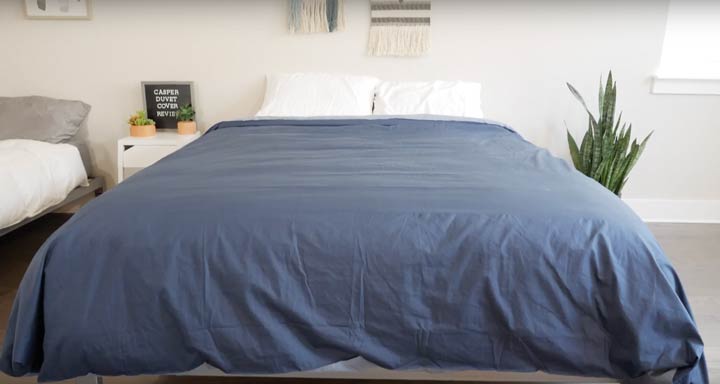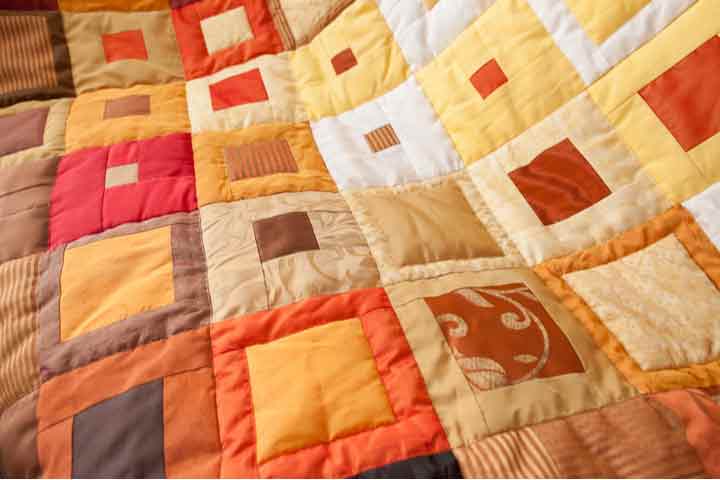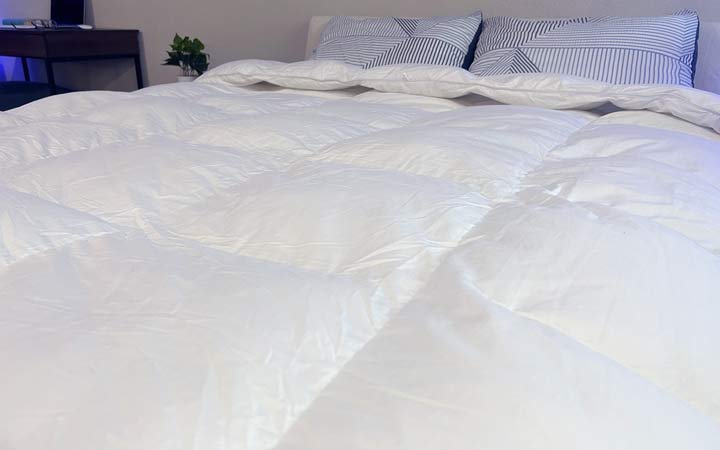Once you start shopping for bedding, you’ll soon realize there are a lot of blanket options on the market. Chances are you’ve heard of bedding like duvets and comforters designed to bring you year-round warmth. But if you are looking for a more lightweight and decorative option, a coverlet could be the solution to your bedding needs.
If you’ve ever asked “what is a coverlet,” keep reading to find out more, ways to use them, and how they compare to other blankets.
What is a Coverlet?
A coverlet is a lightweight blanket used to add a touch of warmth or for decoration. Coverlets are made from one piece of fabric and should drape over your mattress the same way a duvet or comforter would. They can be made from various lightweight materials and feature various designs.

Coverlets can also be used to add color or texture to your bedding aesthetic. They are often made using a matelassé weaving pattern that gives them a quilted appearance and texture. However, coverlets are not made with an inner batting, so they remain thin and lightweight.
RELATED: Types of Blankets
How Do You Use a Coverlet?
One of the main appeals of a coverlet is that they are versatile to use. Coverlets used for decoration are typically folded and placed near the foot of the bed and can be unfolded at night for warmth. You can also place a coverlet between your top sheet and your main blanket to help you sleep warmer. Since coverlets are lightweight, they can also be used as a standalone blanket during the summer or if you sleep warm at night.
Coverlets vs Other Bedding
Coverlets are one type of blanket you’ll find when shopping for bedding. Let’s go over some other common types of blankets and their similarities and differences to coverlets.
Coverlets vs Duvets
A duvet is a plush blanket made with natural or synthetic batting and is designed to be kept in a duvet cover. Duvet covers can be made from a variety of materials, feature various designs, and are usually machine washable for easy cleaning.

Unlike a duvet, coverlets are not made with batting, so they don’t provide as much warmth as a duvet. Although duvets and coverlets can both be functional and decorative, a duvet is more functional than a coverlet and is more typically used as a main blanket.
Coverlets vs Quilts
Coverlets are most commonly compared to quilts because some coverlets have a quilted texture. The main difference between coverlets and quilts is their construction. Quilts are made of two layers of fabric with batting inside for warmth. Coverlets are made with one piece of fabric that may have a stylish quilted texture but does not have batting. A quilt may be more difficult to clean than a coverlet because of its batting material.

Coverlets vs Comforters
A comforter is a thick, plush blanket that contains natural or synthetic filling to provide warmth. They usually include a sewn-through pattern to help distribute filling evenly. Comforters can range in material, price, and thickness, making them versatile to use. Coverlets are thinner and not as plush as a comforter, and they don’t provide as much warmth. Comforters also mainly serve a functional purpose, whereas coverlets mainly serve a decorative purpose.

What are Coverlets Made Of?
Let’s go over some of the most popular fabrics that coverlets are typically made from.
Cotton
Cotton is a commonly used fabric for bedding because of its affordability and breathability. The feel, look, and price of a cotton coverlet depends on its weave style and thread count. Cotton coverlets are often woven to appear quilted and feel soft to the touch. Cotton blankets are also sourced from natural fibers and are easy to care for.
Linen
Linen is a natural fabric most known for its breathability. Its lower thread count, which refers to the number of threads per square inch, allows for ample airflow that makes it a great material for the warmer months. Linen coverlets have a slightly coarse texture that should progressively get softer as you wash them. They are a great fit for hot sleepers or those looking to create a rustic aesthetic for their bedroom.
Microfiber
Microfiber is a lightweight, synthetic fabric that is commonly used to make blankets and bedsheets. It has a similar soft feel to cotton and is also durable and affordable. One thing to keep in mind is that microfiber is slightly less breathable than natural fibers like cotton and linen. So shoppers looking for a functional coverlet for layering should opt for a microfiber option.
When Should I Use a Coverlet?
A coverlet is completely optional to use, but it can be beneficial for a few different occasions. If you live in a cold climate or need some additional warmth during the winter, a coverlet is great to add on top of your duvet or comforter. Conversely, those who live in a warm climate or are hot sleepers could use a coverlet as their primary blanket when a duvet or comforter feels too warm. Coverlets can also be used as decoration to achieve a layered bedding look when paired with a duvet or comforter.
How Should You Style a Coverlet?
Coverlets can be styled with the rest of your bedding in a few ways. If your coverlet is your main blanket, you can spread it over your top sheet and choose to tuck it under your mattress or leave it draped over the side. For extra color or texture, you could add a throw blanket or bed scarf whenever you are not using your bed.

When paired with a duvet or comforter, you have even more styling options for a coverlet. After styling your main blanket on the bed, you can spread your coverlet over it with its sides hanging off the edge. Tucking in the coverlet’s corners with this style gives your bed a neat, tidy look. Another option is to fold the coverlet vertically into halves or thirds and place it near the foot of your bed. This style can give your bed a rustic, layered look to accent the rest of your bedding.
How Do You Wash a Coverlet?
Coverlets are relatively low maintenance and easy to clean. Usually, coverlets are made from machine-washable fabrics like cotton or microfiber. But just like other bedding products, you’ll want to refer back to your coverlet’s tag for care instructions. Some coverlets may require being hand-washed or dry-cleaned.
How often you should wash your coverlet depends on how often you use it. If you are using your coverlet mainly for decoration, you can wash it once every three to four months. But if you are using a coverlet as your primary blanket, you will want to wash it once or twice a month.
FAQs
Can you use a coverlet by itself?
Yes, you can use a coverlet by itself as your main blanket. A coverlet can be a convenient bedding solution in the summer months when a traditional comforter or duvet feels too warm to sleep with.
Does a coverlet keep you warm?
A coverlet can provide an extra layer of warmth when paired with a duvet or comforter, but on its own, a coverlet does not provide much warmth. Coverlets are designed to be lightweight and decorative and are not as thick and plush as a duvet or comforter.
Is a coverlet like a bedspread?
The terms “bedspread” and “blanket” are sometimes used interchangeably. However, a bedspread traditionally refers to a decorative layer that’s styled on top of a duvet or comforter for additional warmth. Although coverlets and bedspreads serve a similar purpose, they do have subtle differences. Bedspreads are meant to hang down to the floor while coverlets are just meant to cover the top of a mattress leaving the bedskirt exposed. Coverlets also tend to be more lightweight and more versatile to style than a bedspread.
How should a coverlet fit?
Whenever a coverlet is laid across your bed, it should hang low enough to cover your mattress, but leave the foundation and bedskirt exposed.

